It’s sometimes useful to repeatedly follow the same path creatively. This is called practice. To understand things deeply and in detail sometimes requires that we repeat familiar techniques and subjects. That’s often what’s required to gain mastery.
However, sometimes new paths appear around a corner—an intriguing diversion to see where it goes. Usually, it’s a self-imposed challenge of some sort, to keep things fresh, like using only shades of white lace when collaging an 8-foot tall polar bear portrait.
Growing as an artist means trying things that are not familiar. Setting yourself challenges is one way to make sure you aren’t treading the same old familiar paths each time you start a new project.
In the photos above, Winfrieda the polar bear ventured out of my studio at the tail-end of a snowstorm in wintery Maine. She seemed to appreciate the fresh air and a taste of her natural habitat. The bit of yellow you see at the tail-end of a car is Tom’s kayak on its roof. It was kept there all winter as he ventured out—onto the ocean (safely and with friends)—appreciating the fresh air as well. Being on the water seems to be Tom’s natural habitat, year-round.
My challenge with this particular fabric collage was to remove “color” completely. I do rely on color to do a lot of the heavy lifting in my artwork, so limiting my palette to only light-colored lace truly was a challenge. But it was something I had been thinking about for a few years, so I felt ready to go for it.
Some of you are thinking, “Well of course you removed color from the equation, you’re working on a polar bear.”
But as all my regular blog readers know, I hardly ever (possibly never?) eliminate color. I happily use color in the most monochromatic subjects. For example, a pink rhino or the portrait of my white dog Kali (photos below)—where I used a value range of blues and purples, especially for her shadowed areas.
I included Kali’s snowstorm photo—our mini polar bear. As I’ve examined polar bear photos, it’s easy to note that they really aren’t “white,” there’s a lot of “cream” involved—just like on our little white dog. I used to wonder how a polar bear could be considered camouflaged in a snowy environment when it really wasn’t the color of snow. Now I understand. In low-light conditions in winter—like evening dog walks (or the Arctic)—Kali is nearly invisible, as I can imagine a stealthy polar bear would be. Good thing we keep her (Kali, not a polar bear) on the other end of a leash, or we could lose her in a drift.
Below, Winfrieda returns to the studio and takes her 8-foot stand at the tail-end of Stevie the 20-foot crocodile. Yeah, I know, what is it about life-sized animal quilts? My marabou stork quilt is the same. I’ve never seen any of these animals in the wild (which I’m perfectly fine about), but I do imagine what it would be like. It’s awe inspiring to think how they really do exist in this world—far, far away from Maine. I guess these are facts I just want to share with others. And how better to show that (safely and two-dimensionally) than to render them in their full size, in fabric of course—so even us stay-close-to-home people can get nose-to-nose with these awesome creatures.
So now let’s get to the meat of this post—the making of Winfrieda the polar bear, Part 2. In Part 1, I showed what I consider to be a first draft—pictured in photos above or in this post from January. I had completed an overall collage piecing of the image (with a few black gaps in her “shadowed” parts to still fill with sheer lace fabrics). Now comes the second draft, where I’ll step back and take a good look at her to decide where she needs adjustment and improvement. There will still be a third draft to come, a fine-tune scouring of all her parts to make sure there’s no more additions, or subtractions, to make prior to quilting.
Below is my second draft list of to-do’s. You may or not be able to understand my writing, but that’s ok. It’s written as shorthand notes that, as long as I can understand it, it’s good. If you signed up and attended (or reviewed the recordings) of the past two Fly on the Wall presentations, you’ll recognize the list. These are all areas I wanted to take a closer look at and probably to adjust one way or another.
Part of my challenge with this piece was to create the darker values and shadows with less layers of lace, allowing the black background to show through. More layers of lace will equal less background showing through. The more black background that is covered, the lighter the value that area will appear. The resulting contrast between the dark and light values is what will give my polar bear the illusion of a nicely rounded body.
A couple of those “shadow gaps” at the top of my list are pictured above left. In this case, I decided to fill and expand on that shadow cast by her arm by adding black lace fabric, not just leaving the gap of background fabric showing through. A few of the lace options are pictured below. In the detail photo, above right, you can pick out at least three of them I used.
A few more points from my 2nd draft list—”wider ankles?” and “add longer hair to ‘trunk-ate’ legs” and “stance.” In her overall photos below, you can start seeing the changes between 1st and 2nd drafts. On the left is Winfrieda at the end of her 1st draft. To the right, you can see how some of her shadows have already been adjusted. She also has less of a waist and less shapely legs.
As I’m revising and tightening up this image, I go back and re-examine my source photos (the one below taken by Frank Sterrett). I always imagined Winfrieda as a matriarchal figure, standing and confronting us. But I kept feeling that something wasn’t “quite right” with her legs. I made those notes listed above, then started to compare what I had already collaged to what I “saw” in the photos. It’s that “looking vs. seeing” content we recently re-posted. What I saw is all the long hair sweeping across a polar bear’s legs, pretty much obscuring any sort of muscular form underneath. Solution: add more lace to her legs, especially along her edges. Done. And by doing that, it also gave Winfrieda a much more grounded and powerful “stance.” Two points crossed off the list.
The photo below right, shows the revisions I made to (our) left paw. In comparison to her photo above, you can see I added some “meat” to that paw, and also adjusted her stomach area by adding more lace, making that area more opaque, rounding out her body.
Another point in this 2nd draft was to tackle the issue of her paws—something wasn’t “quite right” with them either. That’s why working in drafts is so helpful. Even if I know parts of my subject definitely needs more work, I can say, “good for now,” and allow myself to move on. Getting a complete first draft, with changes needed, is better than spinning my wheels in one area and making no progress at all.
Below are in-progress photos from her paw on (our) left. It’s the one I had an idea about as I was finishing up the 1st draft. If my idea worked on that side, I’d apply the same idea to the paw on the other side.
In the paw-sequence photos above is: a detail of the first draft; removal of a flocked sheer “lacy” fabric; replacing it with a crocheted doily (the idea I wanted to try); and lastly, the doily trimmed and pinned, paw edges adjusted, and creating new gaps between the laces to create her claws.
Above and below are before and after photos—1st and 2nd drafts of paw, claws, belly and chest. I think that by re-exposing the black background fabric to show through as her new claws, it gives her paw more dimension. Changing to a “creamier” color of lace for her fingers and top of paw helped as well by adding a value change. The paw on (our) right is still in its 1st draft stage.
By the time it was ready for the most recent Fly on the Wall presentation at the beginning of April, here’s where I was (below) on Winfrieda, as a whole. I had focused on working on (our) left of her body. Partly it was a time constraint, but it also served as a pretty straight-forward comparison of half of her in second draft (our left) to her other half (our right) still in first draft. The idea is that (hopefully) you see a more “well developed” bear on the left than on the right.
I saved much of the 2nd draft work on Winfrieda’s face—especially to “narrow her snout”—for demo and discussion during the Fly on the Wall live presentations. Those folks got to see the back and forth motions I go through as I compare one little piece of lace with another, trying to solve one issue or another. It’s kind of a tedious process, but my viewers seemed to appreciate it. I think it helps when people can see me struggle and hear my internal debate as I put a piece of lace here… or there… or wait, how about over here…?
I always keep my source photo nearby (above from Joel Davidson), and Winfrieda’s progress photo above right, was from the most recent presentation. A few days later I had taken a few more pieces of lace off and on and was at the point you see in photo, below left.
Then I took another look at a forlorn lace doily, above right. It may have arrived as a donation from one of you, my readers. If so, I apologize that it was so quickly assimilated into my stash that I can’t give proper attribution. But know that it was just what I needed to tone down the black lace I had added to her neck shadow on (our) left, see below—it’s the net-like pattern taken from the outside edge of the doily.
Winfrieda now has a due-date at the end of the summer! She’s been accepted to Animalia, an exhibit of animal quilts at the New England Quilt Museum, this fall in Lowell, MA. Maybe you’ll be able say hi to her in person.
Spaces available in two Live Online classes in the last weeks of May and June:
May 2023 Live Online Class
You are invited to join me via Zoom for a 5-Day Live Online Fabric Collage Class. This class is for all levels of fabric collage proficiency, from beginner to advanced. The class runs May 29–June 2, 2023.
• Five-Day Live Online Fabric Collage Classes (Animals Only)
Price: $995 per student
May 29-June 2, 2023
2 Spots Remaining (as of April 21)
Register and pay here:
https://susancarlson.com/product/may-2023-live-online-fabric-collage-class-with-susan-carlson-animals-only/
I have included an update of the number of spots available and will do my best to keep it updated as it changes. If you find on the registration page that the class has sold out and would like to be placed on a waitlist, please email Tom (tom@tomallenbooks.com). Thank you.
Included: Forty-five minute private pre-class coaching session to prepare you for Day One of class.
Required Class Fee: $169 for the Fabric Collage Master Class—an online resource “manual” to refer to before, during, and after class—yours for life ($199 regular price; contact tom@tomallenbooks for coupon code for discount. This fee is waived if you already own the Master Class)
Hardware and Software Requirements: Computer, tablet, or other larger-screen device; reliable internet; ability to photograph and send images of collage in progress (a cellphone is recommended); Zoom meeting software (free to download)
Maximum Number of students: 12
Subject Matter: This class deals with animal subjects—furred, feathered, or scaled—pets, exotic animals, birds, insects, sea life, sea slugs, whatever type of animal appeals to you.
See link below for more information.
https://susancarlson.com/2022/10/29/upcoming-fabric-collage-learning-opportunities-with-susan-carlson/
June 2023 Live Online Class
For the first time ever, I will be offering a portraits-only class. Portraits of people—usually people we know and/or love—are the most difficult of fabric collage pieces because we hope to make them look like the person, of course. In order to open up more class time to focus on specific portraiture issues, I’m limiting this particular class to 8 students.
I’m also classifying it as “intermediate level” as I feel that students need to have a certain amount of familiarity with fabric collage (as I teach it)—either through previous classes with me or independent work through my book, Serendipity Quilts, or my Online Fabric Collage Master Class.
• Portraits Only
June 26-301, 2023
Price: $1490
Class size: 8 max—intermediate level
1 Spot Remaining (as of April 21)
If you are interested in this class or have any questions, please email Tom (tom@tomallenbooks.com) with “portraits only online class” in the subject line.
For more information see the description of my Live Online Fabric Collage Classes.
Included: Forty-five minute private pre-class coaching session to prepare you for Day One of class.
Required Class Fee: $169 for the Fabric Collage Master Class—an online resource “manual” to refer to before, during, and after class—yours for life ($199 regular price; contact tom@tomallenbooks for coupon code for discount. This fee is waived if you already own the Master Class)
Hardware and Software Requirements: Computer, tablet, or other larger-screen device; reliable internet; ability to photograph and send images of collage in progress (a cellphone is recommended); Zoom meeting software (free to download)
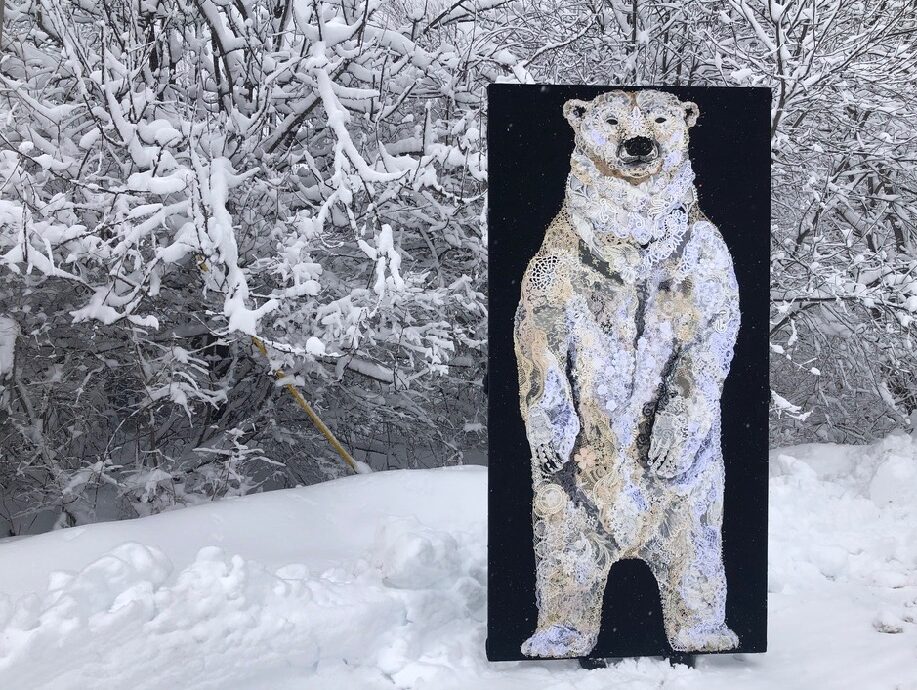










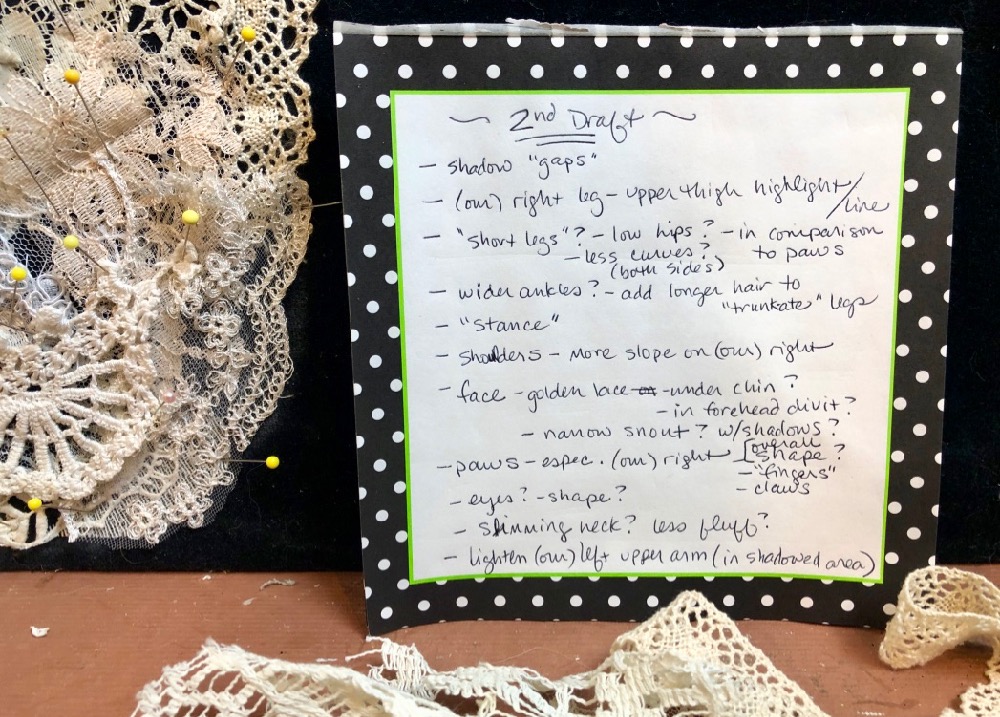
















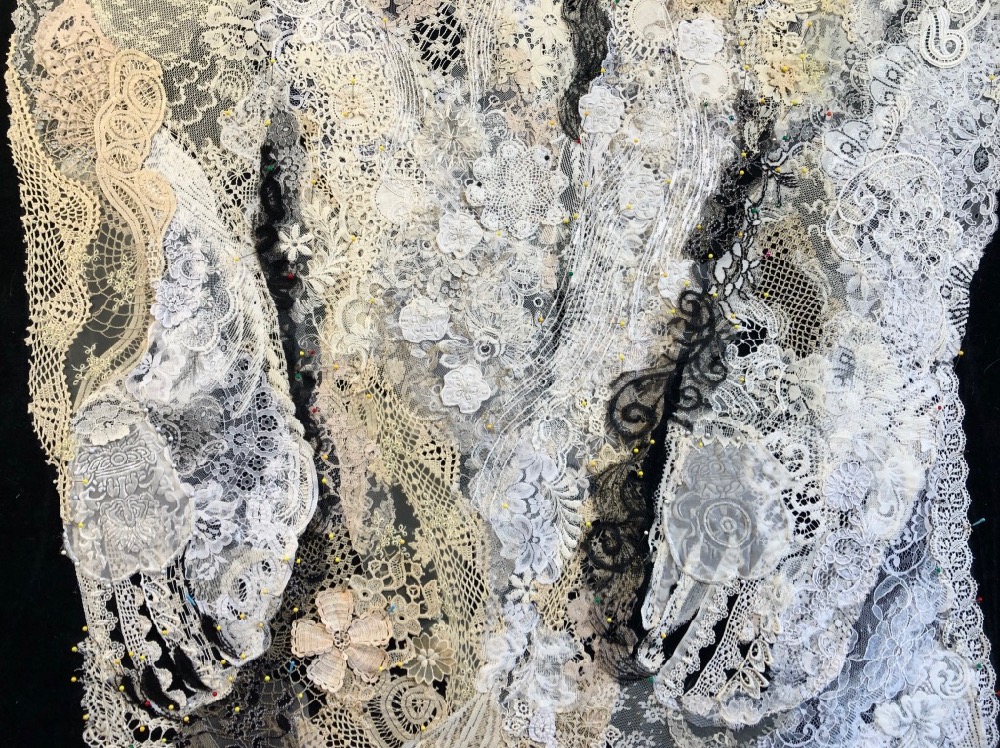
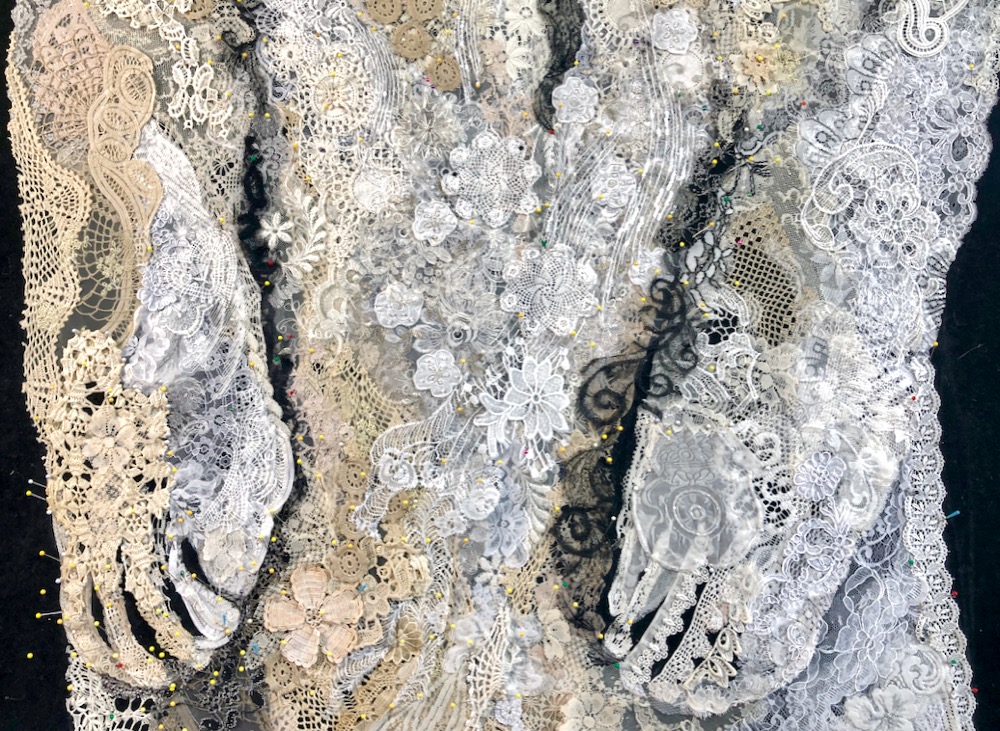




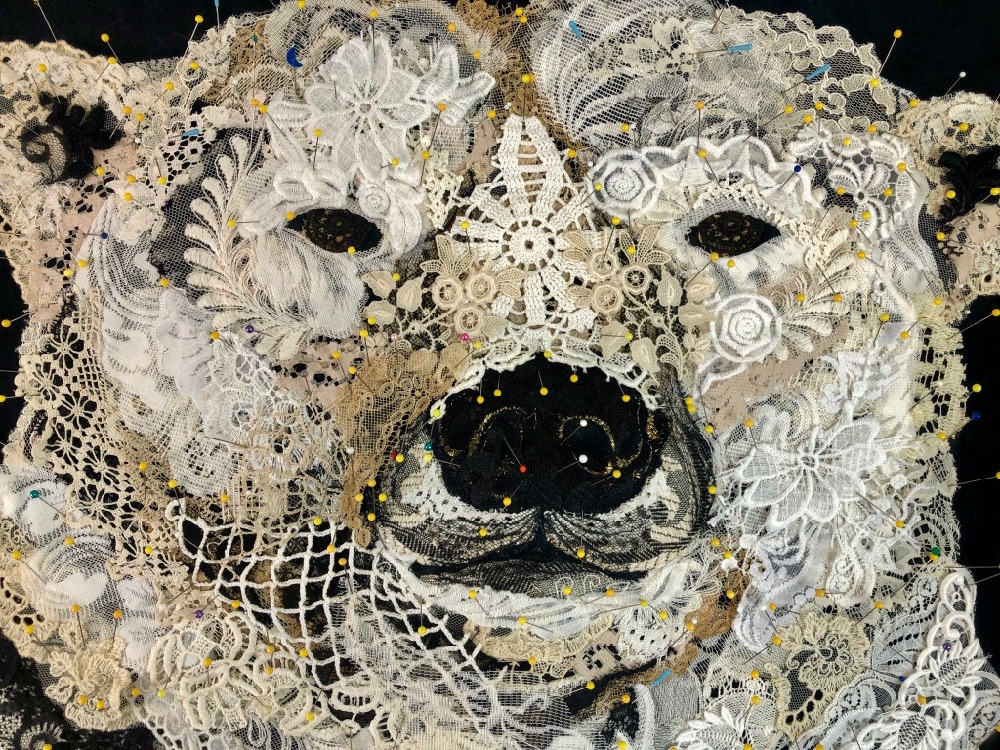
Wow, that’s a lot of pins. I do not envy you the gluing!! Already making plans to visit the wonderful Winfrieda this fall in Lowell.
You’ve done an incredible job of explaining how you fine tune a piece you are working on and taking photos so the differences are plain to see. Winfrieda has developed into a very stately bear.
OMG, this piece is just stunning. Following along as this piece grew has been an amazing journey. And I am just Gobsmacked at the size. What phenomenal Art you are able to create with just bits of lace. I love this one!
Love the lace polar bear.
I love all these creatures and particularly the lace bear. I have been fortunate to see Marabou storks, the crocodiles and polar bears all in their natural habitat. Your quilts are amazingly realistic and bring back great memories of wonderful trips. I have seen your stork and crocodile in person and hope to see Winfrieda in person someday as well. Thanks for sharing I learning a lot watching your series on making the lace polar bear.
I made the trek from the Maine midcoast to Lowell last week to see Winfrieda at the New England Quilt Museum. She is FABULOUS! If you can get there, I highly recommend seeing her regal-ness in person.